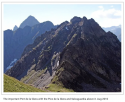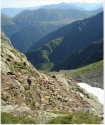Sorry about the long ramble but some good links here I hope..
Here is a really excellent video showing the walk up from Hospice de France, via Refuge de Venasque, up to the Port de Venasque, then up to Sauvegarde and back down to the Refuge de Venasque. This shows I think exactly the route (in reverse) that ED was expected to walk according to DC's dossier.
Pic de Sauvegarde par Port de Vénasque entre Frères ! - YouTube
There are some interesting things from this video:
1. As per DC's dossier, the route down to Hospice de France is relatively easy and it would without doubt be hard to get lost, or fall off any significant height and there seem to be no scree slopes on this bit. If you did fall, you wouldn't fall very far from the main path (unless you strayed off it).Very hard to disagree with DC on this.
2. You get a very good view on the video at 3.36 from the Sauvegarde mountain down to the Boums du Port (lakes at Refuge de Venasque) so it would have been hard to get very disorientated unless there was fog and the weather was reported as excellent.
3. At 6.55 you get a very good view of the path down from Pic de Sauvegarde to the Refuge de Venasque which passes close to the lake. Although not completely impossible, I find it hard to believe she could have unintentionally fallen into the lake from the path.
4. The ground appears hard, rocky and if there was any foul play it is hard to see how she could have been deliberately concealed much.
Further down in the Hospice de France direction, DC reports there was good phone signal and if she had walked down and seen the car park it is likely she might have turned her phone on expecting signal.
The whole area shown on this video has been extensively searched by the search team and also by DC, and also now I expect walked by many people.
All this leads me to the conclusion, as many others have mentioned, that she probably didn't take this route down from Sauvegarde and perhaps she either changed her plan or maybe just felt safer heading back to the Spanish side where she had already been walking. I find it hard to believe that late in the day and on her own she would have decided to take the treacherous route direct from Pic de Sauvegarde to the Port de Glere area which isn't even marked as a path. That means her route down was back to Port de Venasque and from there either (1) French side, direction Refuge de Venasque or maybe further down that evening or (2) to the Spanish side.
On the Spanish side from Port de Venasque, there are three routes (one, directly East completely away from the area- unlikely). One South, down to the Basurta car park and one South West direction of Cascada de Gorgutes (paths here
Rando Le Cirque de la Glère par le Chemin de l'Impératrice (randonnee-nomade.com)). If she had taken the one down to Cascada de Gorgutes then that forms the main path up to Port de Glere from the Spanish side (
Senderismo: Ibon de Gorgutes y puerto de la Glera por Chesco - Pirineos3000). I would have thought there is a strong possibility this formed her onward route to Port de Glere. That route up goes alongside the Torrente de Gorgutes so a small possibility of a fall into water here exists (
) but I doubt this is likely from the video and maps.
This area on the Spanish side described above has been extensively searched by DC at least (and presumably the search team-
Esther Dingley: Partner baffled by no signs of her - BBC News).
However, the area not searched extensively by DC is the French side north of Port de Glere and the area West of this. ED might have got to Port de Glere easily given her fitness and decided to go a little higher East, perhaps to Pic de Sacroux or even Pico Bonneco (2666m). These areas are in the search and rescue area but I doubt it was possible to cover search these areas very easily given the steep topography and probably this area wasn't the first area prioritised.
All of this is relevant because a lammergeier could have moved the bone found a significant distance I think.
Mobile/cellular signal on the Spanish side is interesting (
GSMA - Network Coverage Maps). I think the main networks are Movistar and Orange in Spain. As per the map, signal is very network dependent and we don't know what network ED was on. Orange, for example, has no GSM coverage low down in the valley on the Spanish side but there is weak 3G signal. Movistar has excellent 3G and GSM signal. Vodaphone has no 3G signal at all in the whole area (??- don't believe this). None of the signal coverage maps match what DC reports in his dossier on the French side so there are likely local mountain cellular signal propagation effects altering signal strength (ie. this cellular coverage data is likely very unreliable).






